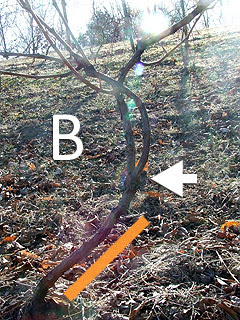
Despite the photo at left, I assure you that this is still a blog about viticulture and not a wine tasting blog, of which there are plenty of fine examples. But I have good reason to feature a bottle of Francis Coppola Diamond Collection Claret Cab Sauv (05). Most of you probably know that I've been bitten by the viticulture bug...I grow grapes in the yard, we have an assortment basement-made wines fermenting in the cellar, I've got a commercial vineyard in development and we decorate the house with empty wine bottles.
But now I need to confess that I'm not merely a vine nut. Another of my overriding passions is motion pictures. A couple years ago, I started writing screenplays just for kicks. I didn't expect much to come of it, but when I finished my first effort, a friend read it and urged me to enter it in a contest. I sent my first feature length spec script to the Nicholl Fellowships (Oscars) last year and it finished a respectable
semifinalst, in the top 30 out of 5,200 submissions. I was blown away, but half thought it was a fluke that this script, The Eulogist, did so well.
Well, this morning I had another surprise. I received an email notifying me that this same script was a finalist, making the
top 10 in Francis Coppola's Zoetrope Screenwriting Competition. Mr. Coppola himself was a judge, and it's humbling to think that one of the masters of American cinema read my little thriller.
So what's all this got to do with wine? Well, as you probably know, Mr. Coppola is not one of the great auteurs of film, but he's also
seriously into wine. And upon hearing of my respectable finish in his contest, my lovely and generous wife purchased a bottle of his Diamond Collection Claret to celebrate. We finished it off tonight.
I don't know what this contest means. I'm not sure if it will lead to a career in film or will just be a nice feather in my cap. With the strike going on now, my hands are somewhat tied. I don't want to cross WGA lines as I someday hope to be a member, and waiting until the end of the strike to send out material means being part of a tidal wave of spec scripts as the industry rights itself again. But a couple things are for certain. I'm hooked on writing screenplays. I've finished two more since writing The Eulogist. And my latest effort, a comedy-drama entitled "Vintage," deals with the subject of wine. I need to find a way to get it into the hands of a producer-type who also is interested in sunlight in bottle form. Hey, maybe Mr. Coppola would would be willing to check it out.
In the interim, I'm keeping my day job and still working to get our vineyard site planted this spring. So far, screenwriting has been a good winter diversion. I'd love for it to turn into something more. But for the time being, my interest in film will have to be balanced with my interest in viticulture. Lots of work to do this spring.
Oh, and some final thoughts on the Coppola Claret. I pulled out my handy
Wine Aroma Wheel and applied it to the great director's Cab Sauv. There was some nice licorice/anise and a touch of strawberry jam and chocolate. Bold, though not overpowering. Not a steal at eighteen bucks, but worth all of that price.
Now I need to change gears and focus on the
Midwest Grape and Wine Conference for a few days. I leave at 5 in the morning. A report will follow.
Cheers!
DB
 I need to restart my vine education. I can tell by my lonely little Golden Muscat vine that things grow differently here in Oregon. No more twelve-foot shoots like back in Missouri. No more six or seven tons of fruit hanging on every acre. A lot less rain during the growing season. It all sounds ideal. Growing grapes should be a snap here compared to the Midwest, right? But I'm sure there is plenty I need to learn about the quirks and challenges a cooler region with fewer heat units during the growing season.
I need to restart my vine education. I can tell by my lonely little Golden Muscat vine that things grow differently here in Oregon. No more twelve-foot shoots like back in Missouri. No more six or seven tons of fruit hanging on every acre. A lot less rain during the growing season. It all sounds ideal. Growing grapes should be a snap here compared to the Midwest, right? But I'm sure there is plenty I need to learn about the quirks and challenges a cooler region with fewer heat units during the growing season.












